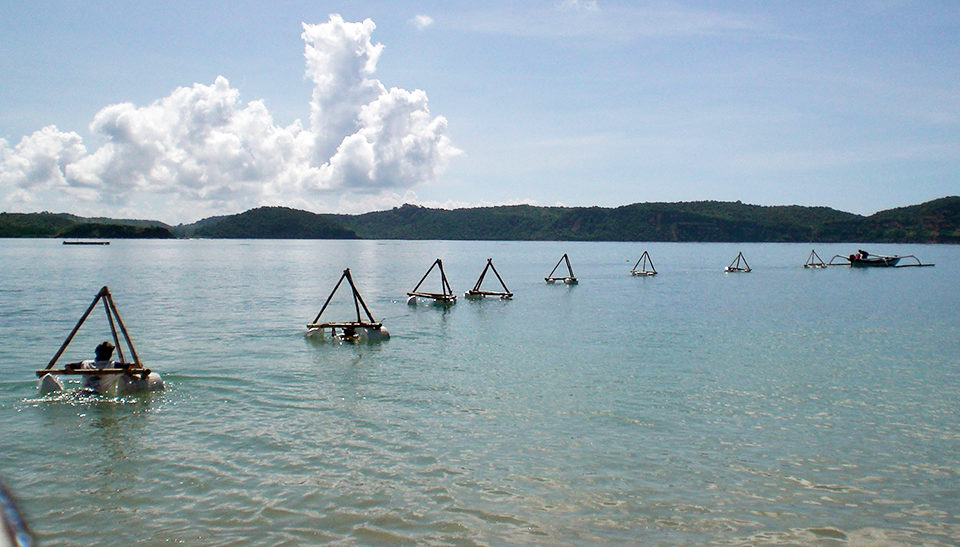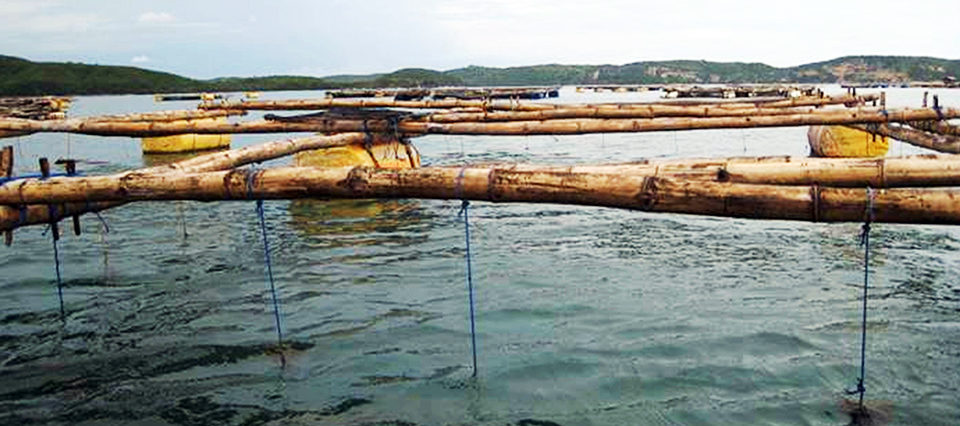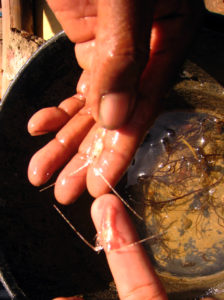Ongoing research examines nutrition, seed sourcing

The farming of lobsters in cages in Indonesia is currently based on a number of small-scale farming units. The industry has further potential in the country, where many coastal lagoons can support the variety of cage designs used. While some standardized production methods have been established, additional work should raise survival rates and improve seed collection.
Feeding
Lobsters cultured in Indonesia are fed entirely with trash fish caught as a byproduct of other fishing activities. Although none of this material was observed directly, it is understood to consist almost entirely of small fish with little mollusk or crustacean content. The food material is very fresh, as there is no delay from catch to use. It is roughly chopped and fed each morning after the night’s fishing activity.
Because relatively fine mesh netting is used in the cages, a significant proportion of uneaten food remains in the cages. In cages observed from 10 a.m. through 5 p.m., there was a large amount of waste material. This is not, conducive to good hygiene or health, and larger mesh sizes may be beneficial. Based on estimates made by farmers, it seems likely that their feed-conversion ratios are around 12 to 15:1.
The current trash fish diet and delivery are far from ideal and may explain the pale pigmentation of the grown-out lobsters. There may be an opportunity to catch additional species of mollusks and crustaceans specifically to supplement the trash fish that are currently fed to the lobsters.
More thorough assessments of the trash fish composition and nutritional quality are required. Recommendations for an improved diet might include a locally made compound diet using the trash fish and other fresh materials along with specific essential ingredients such as binders and vitamin/mineral premixes.
Productivity
High 50 to 60 percent mortality during the puerulus phase is thought to be primarily attributable to cannibalism. Survival of lobsters through the juvenile phase is likely 60 to 90 percent. Although the grow-out phase should have the least problems, some farmers report over 90 percent survival, while others have seen less than 50 percent survival. The proven track record of Vietnamese lobster farmers suggests that with good husbandry and nutrition, growout survival should consistently be above 90 percent.
The time for a 2-cm juvenile to reach market size of 200 g for a P. homarus pasir lobster is about six months and eight months for a 350-gram P. ornatus mutiara lobster. Pasir lobsters initially grow faster than mutiaras, perhaps to 100 g, but thereafter the mutiara growth rate increases faster than that of pasir.
It is difficult to estimate overall production or yield per unit because of the marked variability in the information available. On average, it seems 50 kg of marketable lobsters are produced annually for the typical 3- x 3- x 3-meter cages. The number of cages in which lobsters are grown is on the order of 1,500, so total annual production is likely to be around 50 metric tons (MT).

Improving Pueruli catches

To assess the expansion capacity of lobster aquaculture in the Lombok region, a reliable estimate of the abundance of lobster seed for lobster growout is necessary. An experiment is being carried out to assess the seed resource with replicate standardized seed collectors deployed at 10 locations within the existing seed-collecting areas and in currently unfished areas. The seed includes both the final puerulus larval stage and recently settled juveniles attached to substrates.
Each trap unit consists of a bamboo-framed tripod mounted on styrofoam floats and anchored to the ocean bottom. From the apex of the tripod, a kerosene lantern is secured as the light source. Three trap types are suspended from the corners of the frame.
The first consists of a bundle of netting weighted to ensure it remains submerged. The second consists of a timber pole of approximately 1 m length and 100 mm diameter, in which 10-mm diameter holes are drilled at regular intervals. The third consists of a bundle of rice bag suspended by rock weight. Each trap has six shelters in which lobster seed might settle.
For each location, the four traps have been placed approximately 50 meters apart. Results from this study will be publicized later.
Further goals
After several surveys on the farming activities, seed collecting and product marketing of lobsters on Lombok Island, it is apparent that the following activities could foster further industry development.
A market chain assessment of lobster supply and demand for Southeast Asia would determine the resilience of the market to an increased supply of farmed lobsters. Studies of the ecological impacts of seed collection should examine the impacts of increasing the catch rate of wild seed lobsters, identify new lobster settlement sites and use fishery-independent surveys to establish baseline seed catch data for areas of southern and eastern Lombok. An annual census of lobster seed collection at the established sites of lobster aquaculture industries would also be beneficial.
Puerulus husbandry practices must improve to increase the survival of lobster seed, especially in the first few weeks after capture, when losses typically are 50 percent or higher. Greater feed quality would promote better lobster growth and survival, stronger immunity to disease and better cuticle color.
Editor’s Note: The first part of this article series ran in the July/August 2009 issue of the Global Aquaculture Advocate. It focused on infrastructure and growout methods for lobster culture.
(Editor’s Note: This article was originally published in the January/February 2010 print edition of the Global Aquaculture Advocate.)
Authors
-
Bayu Priyambodo
Marine Aquaculture Development Center of Lombok
P. O. Box 128
Praya Lombok Tengah, Indonesia[109,111,99,46,111,111,104,97,121,64,115,115,101,110,111,108,97,98,97,95,117,121,97,98]
-
IBM Suastika Jaya
Freshwater Aquaculture Center of Tatelu
North Sulawesi, Indonesia
Tagged With
Related Posts

Health & Welfare
Lobster farming in Indonesia
A multinational project in Lombok, Indonesia, is focused on the identification and monitoring of improved seed collection and grow-out production methods for spiny lobsters.

Aquafeeds
A look at phospholipids in aquafeeds
Phospholipids are the major constituents of cell membranes and are vital to the normal function of every cell and organ. The inclusion of phospholipids in aquafeeds ensures increased growth, better survival and stress resistance, and prevention of skeletal deformities of larval and juvenile stages of fish and shellfish species.

Responsibility
A look at integrated multi-trophic aquaculture
In integrated multi-trophic aquaculture, farmers combine the cultivation of fed species such as finfish or shrimp with extractive seaweeds, aquatic plants and shellfish and other invertebrates that recapture organic and inorganic particulate nutrients for their growth.

Intelligence
Lobster aquaculture in eastern Indonesia, part 1
Lobster cage culture has great potential in Indonesia. The current industry consists of about 1,000 small-scale farm units, many of which raise lobsters in polyculture with seaweed and grouper.


